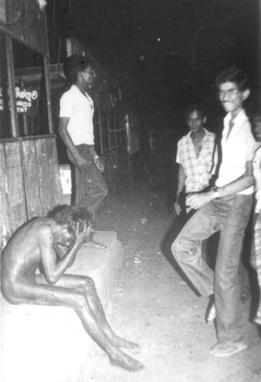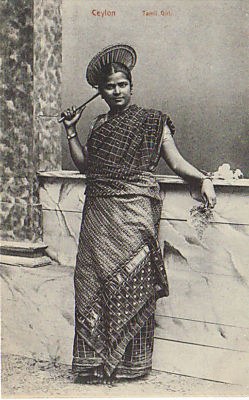
The Sinhalese people, also known as the Sinhalese or Sinhala people are an Indo-Aryan ethno-linguistic group native to the island of Sri Lanka. They are the largest ethnic group in Sri Lanka, constituting about 75% of the Sri Lankan population and number more than 15.2 million.
Burgher people, also known simply as Burghers, are a small Eurasian ethnic group in Sri Lanka descended from Portuguese, Dutch, British and other Europeans who settled in Ceylon. The Portuguese and Dutch had held some of the maritime provinces of the island for centuries before the advent of the British Empire. Burgher people are often referred to as belonging to one of two sub-groups, either Dutch Burghers or Portuguese Burghers, though both are of mixed descent.

Indian Tamils of Sri Lanka are Tamil people of Indian origin in Sri Lanka. They are also known as Malayaga Tamilar, Hill Country Tamils, Up-Country Tamils or simply Indian Tamils. They predominantly descend from workers sent from Southern India to Sri Lanka in the 19th and 20th centuries to work in coffee, tea and rubber plantations. Some also migrated on their own as merchants and as other service providers. These Tamil speakers mostly live in the central highlands, also known as the Malayakam or Hill Country, yet others are also found in major urban areas and in the Northern Province. Although they are all termed as Tamils today, some have Telugu and Malayalee origins as well as diverse South Indian caste origins. They are instrumental in the plantation sector economy of Sri Lanka. In general, socio-economically their standard of living is below that of the national average and they are described as one of the poorest and most neglected groups in Sri Lanka. In 1964 a large percentage were repatriated to India, but left a considerable number as stateless people. By the 1990s most of these had been given Sri Lankan citizenship. Most are Hindus with a minority of Christians and Muslims amongst them. There are also a small minority followers of Buddhism among them. Politically they are supportive of trade union-based political parties that have supported most of the ruling coalitions since the 1980s.

Sri Lankan Australians are people of Sri Lankan heritage living in Australia; this includes Sri Lankans by birth and by ancestry. Sri Lankan Australians constitute one of the largest groups of Overseas Sri Lankan communities and are the largest diasporic Sri Lankan community in Oceania. Sri Lankan Australians consist of people with Sinhalese, Tamil, Moor, Burgher, Malay and Chinese origins among others.
The caste systems in Sri Lanka are social stratification systems found among the ethnic groups of the island since ancient times. The models are similar to those found in Continental India, but are less extensive and important for various reasons. Modern times Sri Lanka is often considered to be a casteless society in south asia.

The Tamil diaspora refers to descendants of the Tamil speaking immigrants who emigrated from their native lands in the southern Indian subcontinent to other parts of the world. They are found primarily in Malaysia, Arab states of the Persian Gulf, South Africa, North America, Western Europe, and Singapore. It can be divided into two main diasporic clusters, due to geographical, historical and cultural reasons, as Indian Tamil diaspora and Sri Lankan Tamil diaspora.

Black July was an anti-Tamil pogrom that occurred in Sri Lanka during July 1983. The pogrom was premeditated, and was finally triggered by a deadly ambush on a Sri Lankan Army patrol by the Liberation Tigers of Tamil Eelam (LTTE) on 23 July 1983, which killed 13 soldiers. Although initially orchestrated by members of the ruling UNP, the pogrom soon escalated into mass violence with significant public participation.

Sri Lankan Tamils, also known as Ceylon Tamils or Eelam Tamils, are Tamils native to the South Asian island state of Sri Lanka. Today, they constitute a majority in the Northern Province, form the plurality in the Eastern Province and are in the minority throughout the rest of the country. 70% of Sri Lankan Tamils in Sri Lanka live in the Northern and Eastern provinces.

The Sri Lankan Tamil diaspora refers to the global diaspora of Sri Lankan Tamil origin. It can be said to be a subset of the larger Sri Lankan and Tamil diaspora.

Tamil Eelam is a proposed independent state that many Tamils in Sri Lanka and the Eelam Tamil diaspora aspire to create in the north and east of Sri Lanka. Large sections of the North-East were under de facto control of the Liberation Tigers of Tamil Eelam (LTTE) for most of the 1990s–2000s during the Sri Lankan Civil War. Tamil Eelam, although encompassing the traditional homelands of Eelam Tamils, does not have official status or recognition by world states. The name is derived from the ancient Tamil name for Sri Lanka, Eelam.
Sri Lankan Canadians refers to people from Sri Lanka who have arrived and settled in Canada. Among these immigrants include members from the Tamil, Moor, Malay, Sinhalese and Burgher ethnicities. According to the 2021 census there are 136,240 Sri Lankan-born persons in Canada.

British Sri Lankans are an ethnic group referring to British people who can trace their ancestry to Sri Lanka. It can refer to a variety of ethnicities and races, including Sinhalese, Tamils, Moors/Muslims and Burghers.
Social class in Sri Lanka is often described as casteless, though caste is still found on the island in both a symbolic and a practical sense. Caste is also used in an analogous sense to refer to the new social class divisions that have appeared in recent decades. The combination of ethnic nationalist movements that saw caste as an island-wide dividing tool, strong emphasis on providing access to education and healthcare regardless of background, and historic lack of discrimination among the colonial civil service played a factor in eradicating the caste system in most sectors of the island's society. Although the Buddhist culture actively fought against all forms of class discrimination, many Buddhist organizations used caste as a method to extract surplus from temple property.
Sri Lankans in India mainly refer to Tamil people of Sri Lankan origin in India and non resident Sri Lankans. They are partly who migrated to India and their descendants and mostly refugees from Sri Lanka because of the recently concluded Sri Lankan Civil War. There is also a small population of Sinhalese people in India, numbering about 3,500 and mostly located in Delhi and Chennai. 57 Sri Lankans have become Indian citizens through naturalization since 2017. According to records with the Union Ministry of Home Affairs, as on January 1,2021, there were 58,843 Sri Lankan refugees staying in 108 refugee camps in Tamil Nadu and 54 in Odisha.
Chinese people in Sri Lanka or Sri Lankan Chinese, are Sri Lankan citizens of full or partial Chinese descent born or raised in Sri Lanka. Most trace their origins to Hakka and Cantonese migrants from the southern coastal regions of China and other Han migrants from Hubei and Shandong who migrated to Sri Lanka in the 17th, 18th and 19th centuries.
Indians in Sri Lanka refer to Indians or people of Indian ancestry living in Sri Lanka, such as the Indian Tamils of Sri Lanka.

Afro-Asians are African communities that have been living in the Indian subcontinent for centuries and have settled in countries such as India, Pakistan, and Sri Lanka.

The Sri Lankan diaspora are Sri Lankan emigrants and expatriates from Sri Lanka that reside in a foreign country.

Tamil settlement of Sri Lanka refers to the settlement of Tamils, or other Dravidian peoples, from Southern India to Sri Lanka. Due to Sri Lanka's close proximity to Southern India, Dravidian influence on Sri Lanka has been very active since the early Iron Age or megalithic period.

Tamils in Italy are people of ethnic Tamil ancestry who reside in Italy. Recent estimates indicate that around 25,000 Tamils from both Sri Lanka and India are living in Italy.












